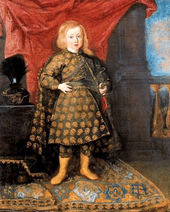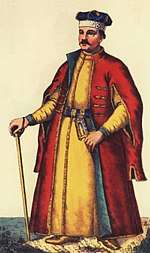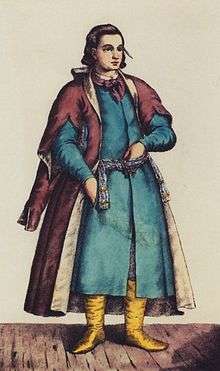Żupan
Żupan (Polish pronunciation: [ˈʐupan]; Lithuanian: žiponas, Czech: župan, Slovak: župan, Hungarian: polgármester, Belarusian: жупан, Ukrainian: жупан) is a long lined garment of Oriental origin which was worn by almost all males of the nobility in the multi-ethnic Polish-Lithuanian Commonwealth. It was a typical upper class male attire from the late 16th to the first half of the 18th century.

Derivation
The name żupan has other spelling variations—czupan (from czupkan, a Crimean Tatar word or alternatively from zuban or ziban—a Turkish word according to Julian Horoszkiewicz), and etymologically related to the Central Asian chapan. Alternatively, the name originates from the Italian word giuppa (gown) which in turn might have come from Arabic (jubba), although the garment itself probably is of Central Asian nomadic origin.[1] or from Middle English / Middle French jupon (an overcoat for armour). Whether the garment came from Central Asia or Ottoman Turkey or Iran still remains a question, and the same applies to the allied male garment—the kontusz. The Central Asian origin of this garment may be also deduced from the method of closure of the pre-1680s zupans, for they were closed from right to left—typical to Central Asian fashion, while the sleeve-ends terminated with dog-ears that were almost like gloves without covering the fingers, and were usually upturned to show the differently colored lining. Eventually an agraffe (clasp) or button was attached to this dog-ear sleeve-end to pin it to a sleeve once upturned and thus a cuff was created. This style of cuff was known in the Louis XIV period in France as the Polish cuff and might have led to the development of colorful military cuffs used in Western armies from 18th century onwards.
After the partition of Ukraine in 1663 (The Ruin), the inhabitants of Left Bank Ukraine continued to wear żupan, the name transliterated into Ukrainian: жупан, and also adopted the kontusz from their Right Bank counterparts as part of their dress, and therefore żupan was worn by Ukrainian nobility, wealthy merchants, cossacks, wealthier peasants and town dwellers as well as new Russian inhabitants - administrators, soldiers, and settlers. Żupan, along with kontusz, was worn also in Russia, especially during the second half of the 17th century, when Polish male costume became popular at the Tsarish court.
Development
During the course of the 16th century the żupan was a popular male costume worn in lands ruled by the Polish Kingdom and Grand Duchy of Lithuania (after 1569 the Polish-Lithuanian Commonwealth). It was worn by males of all social classes, although the most expensive and colorful textiles were used only by the nobility szlachta while other social classes were restricted in color and richness of textiles due to legal restrictions and/or expense costs.
The first mention of żupan appeared in 1393 but it was only gradually adopted as national male garment, first by nobility and later by other social classes, during the course of the 16th century. It was a long robe-like garment, always opened in the front, with long sleeves and a row of buttons (later very often decorative buttons called guzy) and since the 1570s, also a collar. This basic design did not change much but for the size and cut of the collar and type of fabric. Until the 1660s the collars were high, then gradually they became lower and with open, rounded corners. Also at first Żupan served as outer garment made from sturdy cloth or wool and often lined with fur and worn with a belt from which, in the case of nobility, a sword was hung. It was worn underneath the typical outer garments like bekiesza, delia, ferezja, szuba and burka by nobility and wealthier people like merchants. Only gradually it became a lighter garment to be worn underneath the kontusz, while the belt became a colourful affair worn over the kontusz. In case of the poor nobility members and lower social classes it remained the outer garment until its demise, while wealthier burghers would use it as an inner garment along with kontusz and other outer garments in the fashion of nobility.[1]
In Polish military use the żupan served as the outer garment worn on its own by both cavalry and infantry. In the case of heavy cavalry (Polish hussars) and medium cavalry (pancerni) it was worn immediately beneath armour. There was also a padded version after the Central Asian traditions and it then might be called an arming coat, (there is an example of padded żupan in the Polish Army Museum). Żupan was often used in its shorter cavalry version, known as the żupanik.
After the 1680s, the żupan was typically worn beneath a kontusz and in such union those two garments became the typical attire for Ukrainian cossacks as well as the Polish national costume until the mid-19th century.
Construction and color
Żupans were made of many fabrics as were available to the szlachta or the lower classes. Magnates generally wore żupans sporting golden or jewelled buttons, and tailored from the most expensive fabrics of their times such as the very expensive Persian fabric known as crimson, which won their wearers the name, karmazyni or "crimson men", then from various expensive silkbased fabrics like satins, brocades and damascs. Richer szlachta emulated the magnates with cheaper versions of silk-and-linen fabrics while the lower levels of szlachta usually wore żupans made out of cheaper white linen (summer) or duller in colour varieties of wool (winter), hence their nickname, szaraczkowie — "grey men". Colors of Żupan varied, however the lining was always of a different color than the outer fabric.
Other social classes tried to emulate the szlachta. Poorer townsfolk often wore yellowish żupans made from hemp, which resulted in them being nicknamed łyczki. Polish Jews wore black żupans, and peasants wore simple, white (summer) and greyish (winter) żupans from wool or simple cloth.
In 18th-century Poland, the żupan became even lighter, with long and narrow sleeves, while the unseen back was tailored from some inexpensive fabrics such as linen or cotton. It then assumed its final version (when worn with the kontusz and wide, colourful fabric belt) and survived into the 19th century as a part of the Polish "national dress" — integral to regional male costumes, including those of peasants.
Use of the żupan finally started to decline in the 19th century with the coming of the modern western male dress, but the holiday regional peasant costumes in Poland still have zupans as part of their attire. Currently, and for the last 20 years, many reenactment groups in Poland, Belarus, Ukraine, Lithuania, and the USA have been reconstructing and wearing zupans during their shows and gatherings, e.g. Vivat Vasa, Choragiew Jakuba Wejhera or Chorągiew Husarska marszałka Woj. Pomorskiego, Banner of Jasna Gora.
Gallery
 Prince Sigismund Casimir Vasa in a green żupan, c. 1644
Prince Sigismund Casimir Vasa in a green żupan, c. 1644 King John II Casimir in a crimson żupan and delia, c. 1649
King John II Casimir in a crimson żupan and delia, c. 1649- King Augustus III of Poland in a white żupan, c. 1756
 Ukrainian lower middle class citizen in a blue żupan.
Ukrainian lower middle class citizen in a blue żupan. Ukrainian Cossack nobleman in a yellow żupan.
Ukrainian Cossack nobleman in a yellow żupan.
Notes
- Turnau I. (1994) European occupational dress from the fourteenth to the eighteenth century, translated by Izabela Szymańska. Institute of the Archaeology and Ethnology, Polish Academy of Sciences, Warsaw. ISBN 83-85463-26-7
